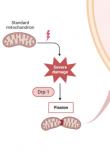Post-translational modification of Drp1 is a promising target for treating cardiovascular diseases
Abstract
Mitochondria are essential for cell growth, fission, differentiation, and survival, especially in undivided cells with high energy requirements such as cardiomyocytes, where they change their shape and position through the activity of mitochondrial fission proteins and mitochondrial fusion proteins. These are significant regulatory mechanisms for cardiomyocyte energy supply and normal function. In mitochondrial fission, Dynamin-Related Protein 1 (Drp1) is involved in the separation and degradation of damaged mitochondria, which accurately regulates the renewal and number of mitochondria. Recent studies have shown that there are a variety of post-translational modification (PTMs) of Drp1, including phosphorylation, SUMOylation, acetylation, O-GlcNAcylation, and S-sulfhydration. These modifications ensure that Drp1 continues to function normally in different signaling pathways by altering its activity, stability, and subcellular localization. This paper provides an overview of the relationship between Drp1 PTMs and cardiovascular diseases such as heart failure, myocardial infarction, and myocardial ischemia-reperfusion, as well as how these modifications can be targeted and regulated to help guide cardiovascular disease treatment.


